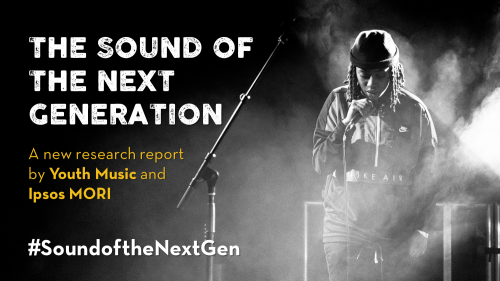
A new research report shows that music is young people’s favourite hobby, equal to gaming and ahead of sport, drama, and dance. 97% of young people had listened to music in the last week and 67% of young people reported engaging in some form of music-making activity.
The Sound of the Next Generation is a new research report published by Youth Music, a national charity investing in music-making projects that help children and young people develop personally and socially as well as musically. The charity works particularly with those who don’t get to make music because of who they are, where they live, or what they’re going through.
Youth Music worked with Ipsos MORI to conduct online surveys with a representative sample of 1,001 young people aged 7 to 17 across England, as well as in-depth interviews with participants involved in Youth Music projects.
This youth-focused research offers ground-breaking insights into the diverse ways young people engage with and value music and music-making, bringing to light the positive and meaningful impact music has for them.
Levels of music-making have increased significantly since 2006, when a similar survey conducted by Youth Music found that just 39% of young people reported making music 1 on a regular basis. The increase reflects what young people are able to do independently, supported by digital technology.
The research found that the most common music-making activities were singing (44%) and playing an instrument (30%) – of which 25% said that they are teaching themselves and 23% have been taught by a friend or family member. The most commonly played instrument – for all ages – was the piano/keyboard, played by 44% of young musicians. Guitar (both acoustic and electric) comes a close second. The next most popular activities are karaoke (14%) and making music on a computer (11%).
The research also shows that those from lower income backgrounds have quite different patterns of engagement with music than those from higher income backgrounds. Many young people with limited financial means are experiencing a rich musical childhood – it just looks different to that of their more affluent peers. It’s more likely to emanate from their home, have a DIY feel to it and less likely to be taught in a formal way.
When comparing survey results for those who were entitled to free school meals 2 to those who were not, 76% of those in receipt of free school meals describe themselves as musical, significantly higher than those who aren’t (60%). They’re just as likely as other young people to sing and play an instrument, were significantly less likely to have seen music at a concert or gig (50% vs 27%), but twice as likely to have reported seeing live music played at home in the last week (45% vs 21%).
They were also significantly more likely to be involved in certain types of musical activity – in particular karaoke, making music on a computer, writing music, DJing and rapping.
Making music videos, producing beats and bars on a computer, DJing, rapping and even karaoke are not activities that have been traditionally been part of formal music education.
Matt Griffiths, CEO of Youth Music said: “This is a missed opportunity to engage young people and support them in their musical development. If young people don’t have access to professional guidance, they’re less likely to have support to progress to more advanced levels of technical competence, to learn from expert role models, to understand the career paths available to them.”
Vick Bain, former CEO of the British Academy of Songwriters, Composers and Authors
(BASCA) said: “The people who are able to access proper music education from an early enough age – so that they have the potential to go on to become professional musicians or composers – are increasingly being privately educated”.
When it comes to musical tastes, young people named Ed Sheeran, Little Mix and Stormzy as their favourite acts, yet overall the 1,001 respondents named 633 different artists spanning more than 300 different genres.
Interests tracked trends from across the decades and included classical music, bebop, jazz, rock and roll, psychedelic rock, punk, new-wave, synth-pop, heavy metal, grunge, hip-hop, R&B, rave, hardcore, jungle, garage, dubstep, and grime. More contemporary styles covered everything from nightcore to K-pop, trap to Afrobeats, and tropical house to moombahton.
Rebecca Allen, President of Decca Records UK said: “If you look at hip-hop right now it is inspiring a whole new generation of jazz artists in the UK. A lot of young 18-24 year olds are going down to these jazz clubs in south London and these artists are combining all sorts of sounds. If you look at Kendrick Lamar, you can see the influences of jazz in his music.”
Matt Griffiths, CEO of Youth Music said: “We are starting to see the clear impact that the digital age is having on young people’s musical consumption and preferences. Greater autonomy and choice is resulting in a move away from genre-based tastes, and instead moving towards a more all-embracing fusion of styles, with a focus on creating the right mood.”
The full report and supporting case studies are available on Youth Music website: www.youthmusic.org.uk/SONG
